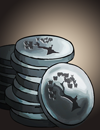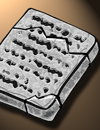The Fallen Cities: Difference between revisions
No edit summary |
No edit summary |
||
| Line 1: | Line 1: | ||
{{Major spoiler}} | {{Major spoiler}} | ||
[[London]] is not the only city to have been brought down to the Neath. Four other cities came before it, all traded to the Bazaar for reasons unknown. Very few wish to consider the possibility of any coming after. | [[London]] is not the only city to have been brought down to the Neath. Four other cities came before it, all traded to the Bazaar for reasons unknown. Very few wish to consider the possibility of any coming after. | ||
Traces of these former cities can be found, usually through their relics. First City coins, Second City tablets, Third City statues, and those ever-popular Fourth City horsehead figurines. Eager (and persistent) archeologists can find out more about these lost civilizations. The Fourth City is the easiest to learn of by far, as a remnant stands just outside the city: the Forgotten Quarter. The more adventurous zailors of the Sunless Sea may also choose to embark on a voyage to the Khanate, the floating city-state established by Fourth City refugees. | Traces of these former cities can be found, usually through their relics. First City coins, Second City tablets, Third City statues, and those ever-popular Fourth City horsehead figurines. Eager (and persistent) archeologists can find out more about these lost civilizations. The Fourth City is the easiest to learn of by far, as a remnant stands just outside the city: the Forgotten Quarter. The more adventurous zailors of the Sunless Sea may also choose to embark on a voyage to the Khanate, the floating city-state established by Fourth City refugees. | ||
Neathy immortality also means that people from these cities have survived on into London as well, although a majority of their denizens have left for the Tomb Colonies. After all, these cities stretch far back into antiquity. Anybody who could survive that long and still remain a part of Fifth City life is either incredibly wily, powerful, or both. | Neathy immortality also means that people from these cities have survived on into London as well, although a majority of their denizens have left for the Tomb Colonies. After all, these cities stretch far back into antiquity. Anybody who could survive that long and still remain a part of Fifth City life is either incredibly wily, powerful, or both.__forcetoc__ | ||
==The First City, date unknown== | ==The First City, date unknown== | ||
Revision as of 21:05, 7 May 2019

|
Beyond this point lie major spoilers for Fallen London, Sunless Sea, Sunless Skies, or Mask of the Rose. This may include endgame or major Fate-locked spoilers. Proceed at your own risk. You can find out more about our spoiler policy here. |
London is not the only city to have been brought down to the Neath. Four other cities came before it, all traded to the Bazaar for reasons unknown. Very few wish to consider the possibility of any coming after.
Traces of these former cities can be found, usually through their relics. First City coins, Second City tablets, Third City statues, and those ever-popular Fourth City horsehead figurines. Eager (and persistent) archeologists can find out more about these lost civilizations. The Fourth City is the easiest to learn of by far, as a remnant stands just outside the city: the Forgotten Quarter. The more adventurous zailors of the Sunless Sea may also choose to embark on a voyage to the Khanate, the floating city-state established by Fourth City refugees.
Neathy immortality also means that people from these cities have survived on into London as well, although a majority of their denizens have left for the Tomb Colonies. After all, these cities stretch far back into antiquity. Anybody who could survive that long and still remain a part of Fifth City life is either incredibly wily, powerful, or both.
The First City, date unknown
"Only two things are known to remain of the First City: the name, the Crossroads Shaded By Cedars, and the saying: even the First City was young when Babylon fell."


The First City used to be considered to have been Uruk, in Mesopotamia. The remnants of the city live on in Polythreme. To reason this, it must be assumed that the saying above was accidentally transposed over several hundred/thousand years. Some have debated, however, that it's the Hurrian city of Nagar, in modern-day Tell Brak, in which an eye temple mentioned in the game is located.
There are a few confirmed living survivors of the fall of the First City:
- the manager of the Royal Bethlehem Hotel. He's either Gilgamesh (hinted at by a number of similarities in the game) or a Hurrian king.
- Polythreme's King With a Hundred Hearts; if the Manager is Gilgamesh, then the King is an allusion to Enkidu (Gilgamesh's closest friend in the epic). However, there are also references to him being a merchant from China.
- the Capering Relicker, who was the first to brew Hesperidean Cider. There is a theory that he is actually Utnapishtim, as he is the Manager’s uncle.
- Additionally, the Cladery Heir's mother is from the First City, and she is spoken about as if she were still alive.
It is possible if the Manager of the Royal Bethlehem Hotel is Gilgamesh, and the King With a Hundred Hearts is Enkidu, who dies by the end of the Epic of Gilgamesh, that the former precipitated the fall of the First City through bargaining for the latter's survival with the Masters. This is only speculation, however, though it is noteworthy there are (presumably non-canon) sequel tablets to the Epic of Gilgamesh that detail Enkidu's journey out of the underworld and back to Gilgamesh, who may have even been his lover.
The Second City, circa 1335 BCE
"Never mention the Second City to the Masters of the Bazaar. Mr Wines will look at you narrowly and give you its worst vintage. Mr Cups will fly into a rage. Mr Veils will harangue you for your discourtesy. Mr Iron will say nothing, only write down your name with its left hand."
"Certain of the Masters of the Bazaar - Mr Stones, Mr Apples and Mr Wines, and possibly others - seem to have a particular contempt for Egypt and the Egyptological. Perhaps they're simply reacting to the fashion for the Pharaonic that overcame London before the Descent. But it's unusual that they should care."

The Second City was definitely Amarna in ancient Egypt, judging by the snippets above and some interestingly intertwined facts about the Duchess and her family. The remnants of the city may live on in the Iron Republic.
A living survivor of the fall of the Second City is the Duchess (Pharaoh Tutankhamun's sister/wife, Ankhesenamun); she orchestrated the fall to save her husband's life. Well, maybe. After falling out of favor with the Masters, King Tut was transformed into the Cantigaster. (Maybe. Or did she do it?) Some of the people of Visage might be descendants of survivors of the fall of this city.
The Third City, 800s-900s CE
"No-one talks much about the cities that preceded London. The Third City seems to have been acquired a thousand years ago. It had five wells, they say. And the weather was better."
The Third City was Mayan. The three most likely candidates are Chichen Itza, Tikal, or Hopelchén (the latter doesn't fit the 'powerful' criteria of the first two, but its name means "five wells"). The majority of tomb-colonies are primarily based upon Third City architecture and mythology. The remnants of the city live on in the Elder Continent.
There are a handful of living survivors of the fall of the Third City: the supposed tomb-colonist Feducci, the Presbyter on the Elder Continent, and the God-Eaters, for example. It is unknown whose life was saved in exchange for the city, though Mr Eaten (whom the other Masters hated anyway) might have been sacrificed as payment for the city. (Regardless of why, Mr Eaten was certainly nearly destroyed. Little remains of it. Said remains should not be discussed by any sane individual.)
The Fourth City, 1254 CE
"Who carves horse-head amulets out of bone? Whoever lived in the Fourth City. If all the Fourth City amulets on sale are real, they must really have liked horses."
The identity of the Fourth City has been conclusively proven in The Silver Tree (a standalone Storynexus game about the Fourth City) to be Karakorum, once the capital of the Mongol Empire.
A living survivor of the fall of the Fourth City is the Gracious Widow (who is the daughter of Mongke Khan, and whose real name is Cheren). It was her forbidden love for William of Paris, a European artist, that brought Mr. Wines to the city. It's unclear whether Cheren herself or her father the Khan made the deal for the fall of the city as The Silver Tree has multiple contradictory endings.
The remnants of the Fourth City live on in London's Forgotten Quarter, in Port Carnelian, and in the Khanate in the Unterzee.
In Sunless Skies, after the gate to the High Wilderness at the Avid Horizon was opened, most Mongolian residents of the Neath passed through and established a new Khanate at Eagle's Empyrean.
The Fifth City, 1861 CE
"The city around the Bazaar is called the Fifth City because, they say, it's not the first the Bazaar chose as a home. You can still turn up bricks from the older cities, now and then. Look: here's one marked with an eye."
There are numerous living survivors of the fall of London. It is widely known that Queen Victoria (the Traitor Empress) arranged the Fall to save Prince Albert (the Consort)'s life. Already the Consort seems rather wan, and something else has already befallen the royal family...
The Sixth City, and the Seventh?
It is hinted in several places that in non-Skies timelines, Paris will be the Sixth City. Makes sense. After all, Paris is the City of Love.
Moscow may be the Seventh (and final) City. It will apparently fall when Halley's Comet next arrives. That's in 2061... we'll see.
Some content from NiteBrite; most information from http://community.failbettergames.com/topic23-fallen-cities-a-great-many-spoilers.aspx.